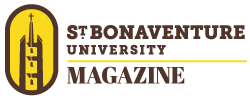
Students recruited by $600,000 STEM grant four years ago discover camaraderie along with scholarship
Meet four recent St. Bonaventure graduates who were participants in the “Discovery Within Community” National Science Foundation grant program. All said the NSF scholarship made it possible to attend the university, or solidified the school as their top choice, and all are on a path to careers in STEM fields.

Read about
Alexandra Izydorc

Read about
Geoffrey Broadbent

Read about
Nicholas Martel

Read about
Eric Wojcik
By Tom Donahue
Thirteen students recruited by St. Bonaventure University four years ago with scholarships funded by a nearly $600,000 National Science Foundation grant left campus with diplomas in hand this past May.
All earned degrees in disciplines related to science, technology, engineering and mathematics, and many are on a path to STEM-related careers.
The success of the $594,287 “Discovery Within Community” grant has inspired university officials to seek a Track Two NSF grant in order to enroll another cohort of students interested in STEM-related studies in the fall of 2020.
The grant program that just ended enabled the university to recruit 25 academically talented students with financial need to its majors in biology, chemistry, computer science, mathematics and physics as freshmen in the fall of 2015.
“Not enough young people are going into these fields to fill the jobs that are needed, so the purpose of these NSF grants is to increase the numbers going into STEM graduate programs or careers,” said Fr. Peter Schneible, O.F.M., associate professor of biology and department chair. Fr. Peter served as principal investigator for the grant and oversaw administration of the program funded by the award.
“We called the grant ‘Discovery Within Community’ because we wanted to build on the community structures already in place at St. Bonaventure,” said Fr. Peter. The grant provided scholarship recipients with tutoring and academic support through the university’s Learning Center, and career-preparedness services from the Career and Professional Readiness Center. Most program participants completed the CPRC’s Competitive Edge Certificate program, which arms students with skills sought by employers and graduate schools.
The students also took courses together, attended and presented at group conferences, and came together for numerous on-campus symposia that included presentations by area professionals in STEM-related careers.
“The goal was to create a camaraderie among them based upon the common classes they took and common experiences they had,” said Fr. Peter. “We brought the various majors together to stress the interdisciplinary nature of contemporary science, to let them see that most jobs in science now involve not just biology, let’s say, but also chemistry, physics and computer science, and vice versa.”
The program’s objective was to recruit students in each of the university’s five STEM disciplines, and for 90 percent of the 25 scholarship recipients to graduate with a STEM-related degree, then embark on a career in STEM or enroll in a STEM graduate program.
Thirteen graduates from an initial cohort of 25 students means the 90-percent graduation goal wasn’t met, but not that the program wasn’t a success, said Dr. David Hilmey, associate professor of chemistry and one of the grant’s four other co-principal investigators, who was named dean of Arts and Sciences one year into the grant program. Bad timing jeopardized hitting the 90 percent mark from the start, said Hilmey, as notification of the grant approval came in the middle of the annual admissions cycle, when many college-bound high school seniors had already narrowed their list of desired schools.
“We started with numbers that didn’t quite match up with where we wanted to be, so we brought in a group of students that included some who knew what they wanted to go into, but a number who didn’t. Some of the students eventually decided to go into different areas and left the STEM fields, resulting in their being dropped from the program,” said Hilmey.
“But for the students who took advantage of the grant, it was a strong program that had a lot of success,” he said. “The programming that Fr. Peter put together really gave students a first-hand view of not only what they’d gotten themselves into, but where they could see themselves in the future.”
As it did with the initial grant, the university worked with the Washington, D.C., based consulting firm McAllister & Quinn in preparing and submitting the Track Two grant, said Ann Lehman, associate vice president for grants and research, and chief of staff at St. Bonaventure.
The new grant includes a shared residential community for the scholarship recipients, a feature of the first grant for which there was insufficient time to implement. “It also includes additional activities to create more cohesiveness among the students,” said Lehman.
A determination on the Track Two grant is expected this summer.
